How to Prepare Statement of Cash Flows in 7 Steps
How many times did you sit with the head in your hands worrying about the statement of cash flows? Lots of work, preparation, calculations, adjustments…. and damn it, figures just do not add up! It’s very frustrating and creates headaches. I’ve been there.
You might find making cash flow statements one of the most challenging issues no matter whether you use US GAAP (if you’re in the USA) or IFRS (if you are in one of more than 120 countries in the world applying IFRS). Many people also struggle with preparing IFRS statement cash flows because…
- It’s the only statement prepared on a cash basis, not on an accrual basis;
- Accounting records must be adjusted to exclude non-cash items which might be quite demanding.
Maybe it looks very complicated, but don’t worry, people make much more serious IFRS mistakes than cash flow statements! If you subscribe to my e-mail updates you’ll get my free report “Top 7 IFRS mistakes” and you’ll learn how to avoid these mistakes, too.
But let’s be clear in one point: You still need a good method and resources to prepare statement of cash flows in line with IAS 7. I personally hated to prepare cash flows until I learned this simple method that I am going to show you.
UPDATE 2018:This article has already got a lot of attention and I’m grateful for this. Therefore, I published a video with step-by-step illustration of making cash flow statements. This video comes from my IFRS Kit, but if you’d like to watch it for free, please subscribe to my newsletter (by entering your e-mail address to the form on the right sidebar) and you’ll get it within my free IFRS mini-course. Enjoy!
Before Start
This method works only if you understand the following matters:
-
- You already know what the statement of cash flow is and what parts it has (operating, investing, financing and final reconciliation). You understand the basics of cash flows, relationship between individual components of financial statements (balance sheet, income statement and others), accounting etc. If that’s not the case, I sincerely recommend watching our online videos on these topics—in particular IAS 1: Presentation of Financial Statements and IAS 7: Statement of Cash Flows.
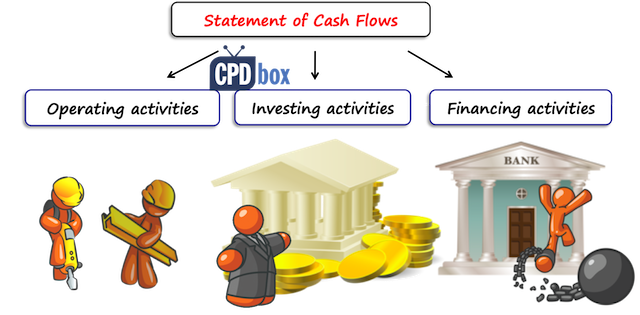
- Availability of various accounting information is generally good and you can easily access them. Sometimes you will need to do some adjustments resulting from supporting data and it would be lovely if you could get all pieces of info in the blink of an eye.
- You will stay cool, no nerves, no stress, just patience and concentration on this lovely work.
Ready? So let’s start. We are going to learn how to prepare statement of cash flows by indirect method.
Step 1: Prepare—Gather Basic Documents and Data
In order to start, you shall obtain at least the following documents:
- balance sheet (statement of financial position) as at the end of the current reporting period (closing B/S) and as at the beginning of the current reporting period (opening B/S)
- statement of comprehensive income (profit or loss statement + statement of other comprehensive income if applicable) for the current reporting period
- statement of changes in equity for the current reporting period
- statement of cash flows for the previous reporting period—well, you can proceed further without this, but it’s good source of potential recurring adjustments in the current period
- information about material transactions in your company during the current reporting period. Of course, you can adjust your statement of cash flows also for immaterial items, but it would not significantly change the information value of cash flow statement (since it’s immaterial, but careful about aggregation), so I would not bother about it
The first four bullets are crystal clear, but what sources of information about material transactions to use? Here is the short list of my ideas what to look for:
- major contracts that your company entered into during and before the end of the reporting period (lease, rental, hedging, construction—all sorts of)
- minutes or memoranda from the meetings of managing bodies in your company, like board of directors’ meetings, supervisory board meetings, shareholders’ meetings, audit committee meetings, etc.
- files from your legal department related to any proceedings against your company (and the opposite cases, too)
- documents from your investment/long-term assets department to look for major purchases, sales, exchanges and other transactions with fixed assets
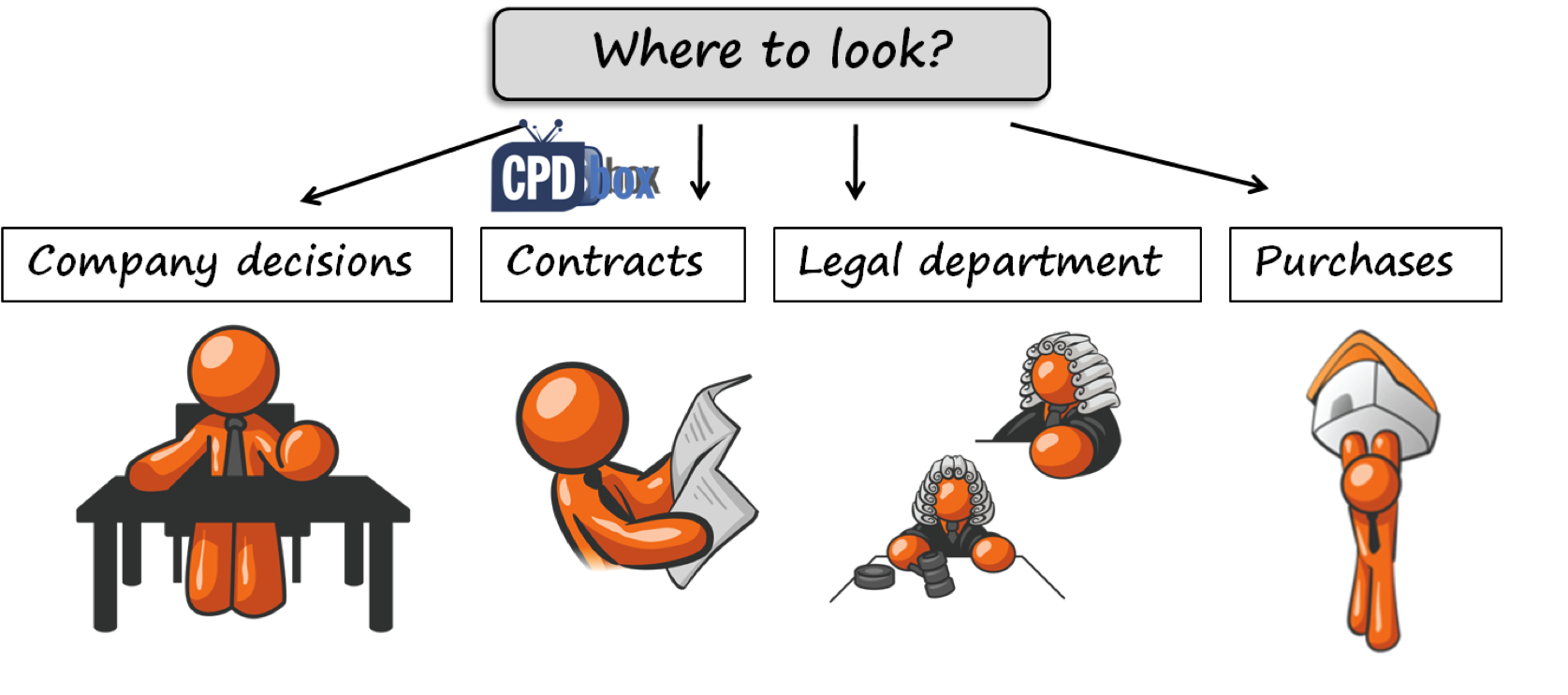
That’s just a general shortlist and I am sure you know better what kind of transactions might be significant in your company—so go, ask and look for where you think it’s appropriate.
Step 2: Calculate Changes in the Balance Sheet
Now, take the closing and opening B/S and make a simple table with 3 columns: the first column – title of caption in B/S (for example, tangible non-current assets), the second column—balance of this caption from the closing B/S and the third column—balance of this caption from the opening B/S.
As you sure know, each B/S has 2 parts – assets and equity & liabilities. Ideally, totals of both parts should be the same, right? So when you do this simple table, please, enter assets with “+” sign and equity & liabilities with “-“ sign. Now do the check – if you entered the signs and numbers correctly, total of all assets and equity & liabilities should be 0 (don’t include subtotals).
In the 4th column, calculate changes in the balance sheet over the current period. Use simple formula: opening B/S minus closing B/S (careful, not the vice versa!). When you calculate all the changes correctly, total of all changes will be 0 (again, don’t include subtotals). Just let me add that you can use your general ledger accounts instead of balance sheets and you will get greater details as balance sheet represent aggregated figures. It really depends on the level of details you need.
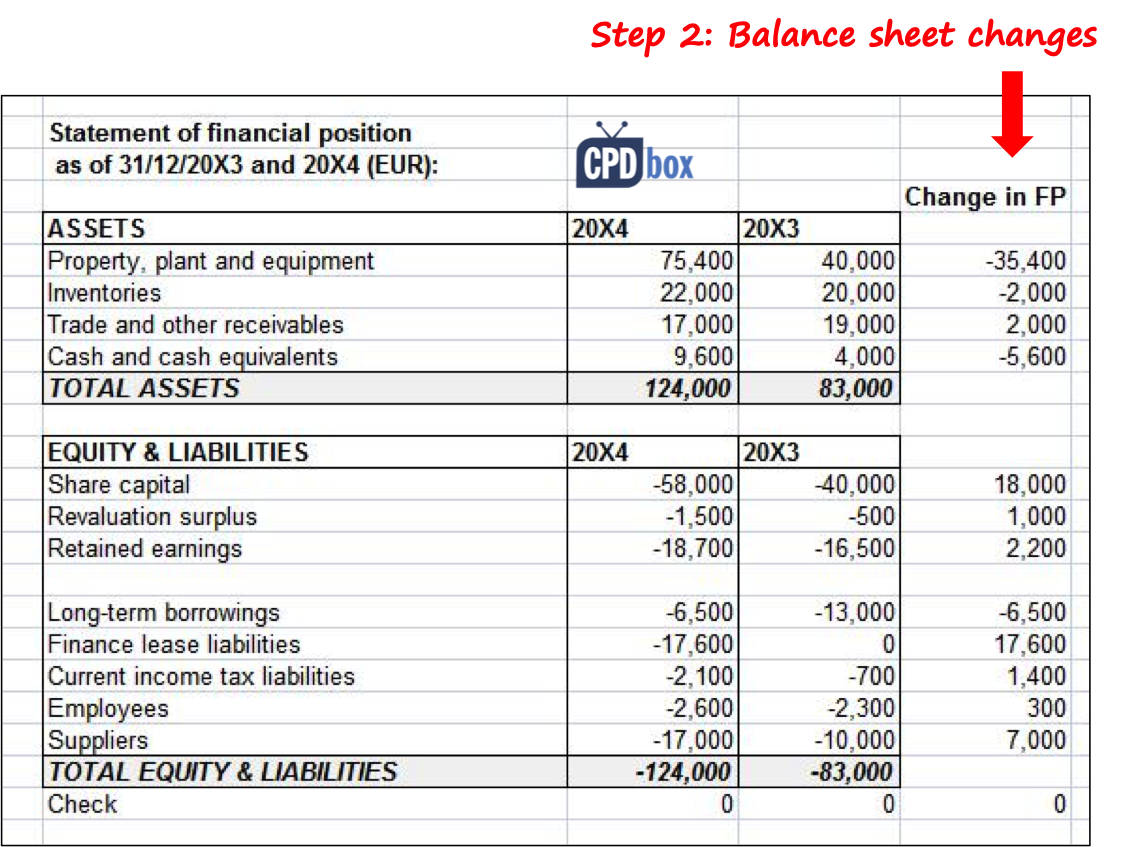
That was an easy bit, agree? But it’s very important to do it properly and not mix the signs and formulas. So you better check it again before moving further.
Step 3: Put Each Change in B/S to the Statement of Cash Flows
By now, you should have a blank statement of cash flows ready for further work. Ideally, you can use the statement of cash flows from previous period and take only titles of individual captions. Likely you will have the same items also in the current period cash flows. Anyway, you can always insert a line for some new items if necessary.
The rationale behind this step is that each change in the balance sheet has also some impact on the cash flow statement—and if not (when movement in balance sheet is fully a non-cash item), it will be adjusted for later.
So now you should look to all changes in your balance sheet and enter each number to the blank form of cash flow statement. For example, you have calculated that change in your property, plant and equipment is -10 000, so you enter this figure in the investing part of your blank cash flows under the title “purchases of PPE” (as a change was minus 10 000, it means that the company spent the cash to purchase PPE).
You shall continue assigning each change in the balance sheet to the statement of cash flows until you finish all. When you are done, you should have a statement of cash flows with 2 columns—1st column = titles of individual cash flow captions and 2nd column = changes in the balance sheet assigned. Now perform a check—total of the 2nd column shall be 0 (without subtotals). If it’s not, you have done something wrong, so go back and review.
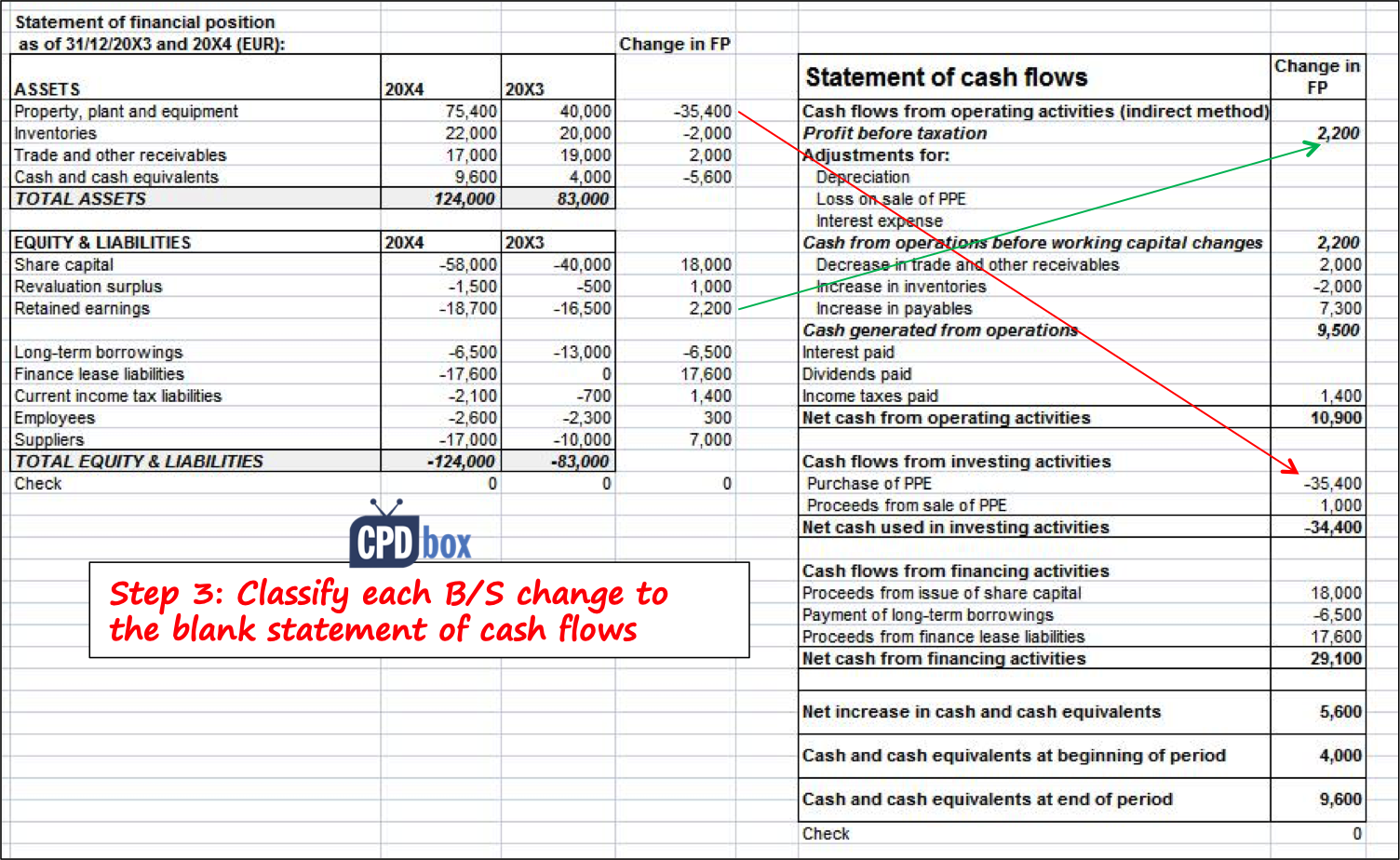
Well, if you’d like to know precisely where to put individual changes and how it looks like, please watch our video IAS 7: Statement of Cash Flows—each step is explained very clearly in detail in Excel file with all numbers included.
Step 4: Make Adjustments for Non-cash Items from Statement of Total Comprehensive Income
By now, you have a solid base to finish your cash flows successfully. However, these figures do not mean anything. We have more work to do.
Take the profit or loss statement and statement of other comprehensive income. Then identify any numbers where non-cash transaction might have been recorded. Typical non-cash adjustments are usually as follows:
- depreciation expense
- interest income and expense
- income tax expense
- expense for recognition or income from derecognition of various provisions
- change in revaluation reserves
- foreign exchange differences at the end of period
- revaluation of certain assets and liabilities at the end of period
- barter transactions
and many more.
So once you identify non-cash transaction, just make adjustment in the blank statement of cash flows. Do each adjustment in the separate column. Making adjustments means simply adding one number to one caption and deducting it from the other one. It’s like doing double bookkeeping. The trick is to identify: 1) which captions in cash flows are impacted by non-cash item and 2) where is the plus side and where is the minus side.
For example, let’s take depreciation expense. On one side, it causes non-cash decrease in profit figure, so it should be added back. Just enter the figure in the operating part under the heading “adjustments for non-cash items: depreciation” with a plus sign. And where do we put the same figure with a minus sign? Well, depreciation artificially increased total payments for purchases of PPE. So we just deduct it from the investing part under the heading “purchases of PPE”. Perform a check—total of adjustment shall be 0.
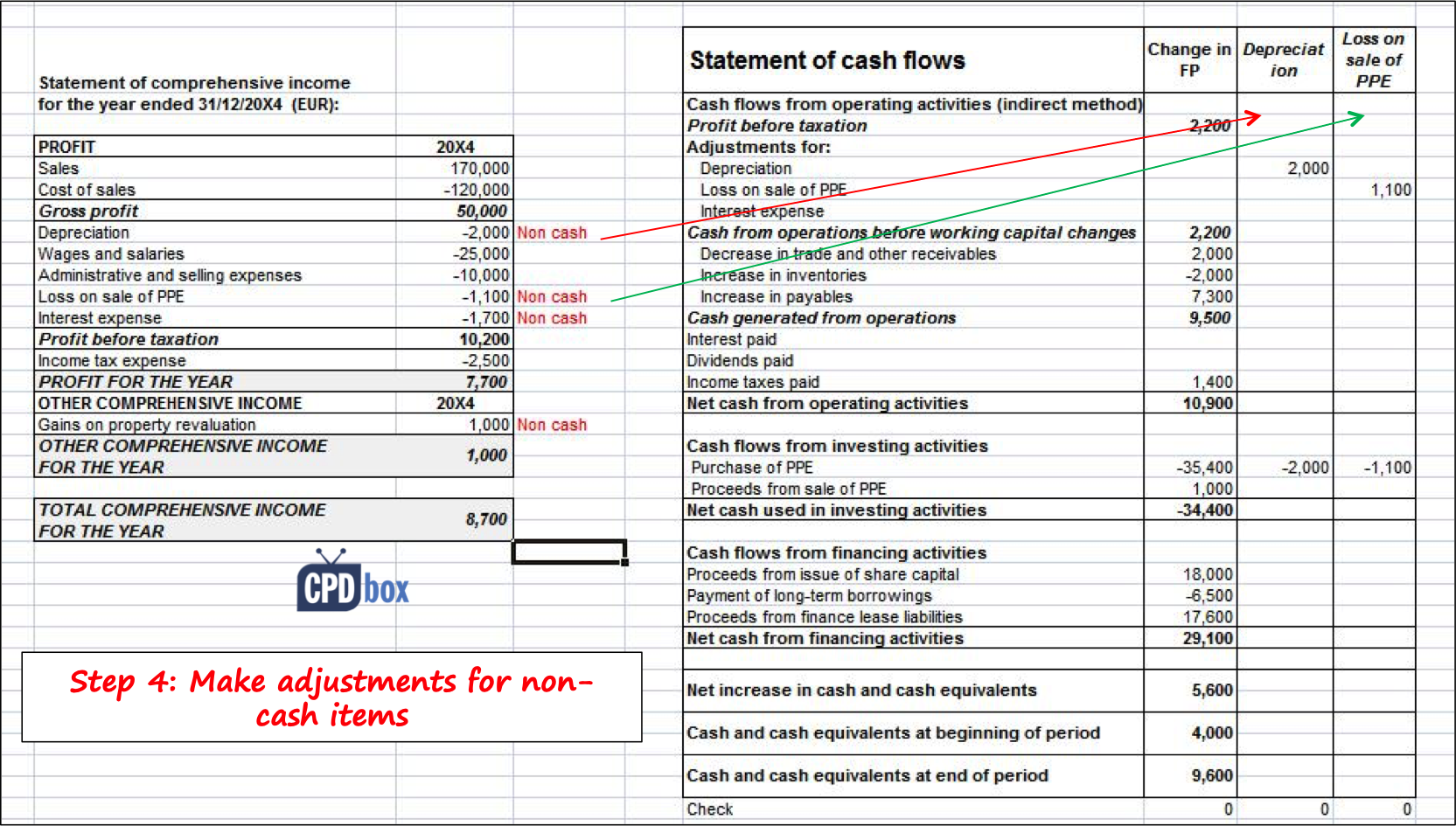
Go on until you are done with all identified non-cash adjustments from statement of total comprehensive income. And remember to verify your totals after each adjustment.
Now I know this is probably the most difficult part, because sometimes it’s hard to identify where to put the change and which sign to use. But the principle is always to do both sides of adjustment and keep your totals to be 0.
Again, let me remind you that our comprehensive step-by-step example included in IAS 7: Statement of Cash Flows video shows various types of non-cash adjustments and explains how to deal with them.
Step 5: Make Adjustments for Non-cash Items from Other Information
Step 5 is pretty much the same as step 4, but now you shall look to other information sources. I listed several of them in step 1.
So for example, you find out that your company entered into new material lease contract. And there is a non-cash adjustment hidden for sure, because on one side, increase in PPE was recorded that was not purchased for cash. On the other hand, increase in loans or lease liabilities was recorded, but the company have not received any cash. So you shall adjust for it, exactly the same way as described in the step 4. Remember about your total—it should be always 0.
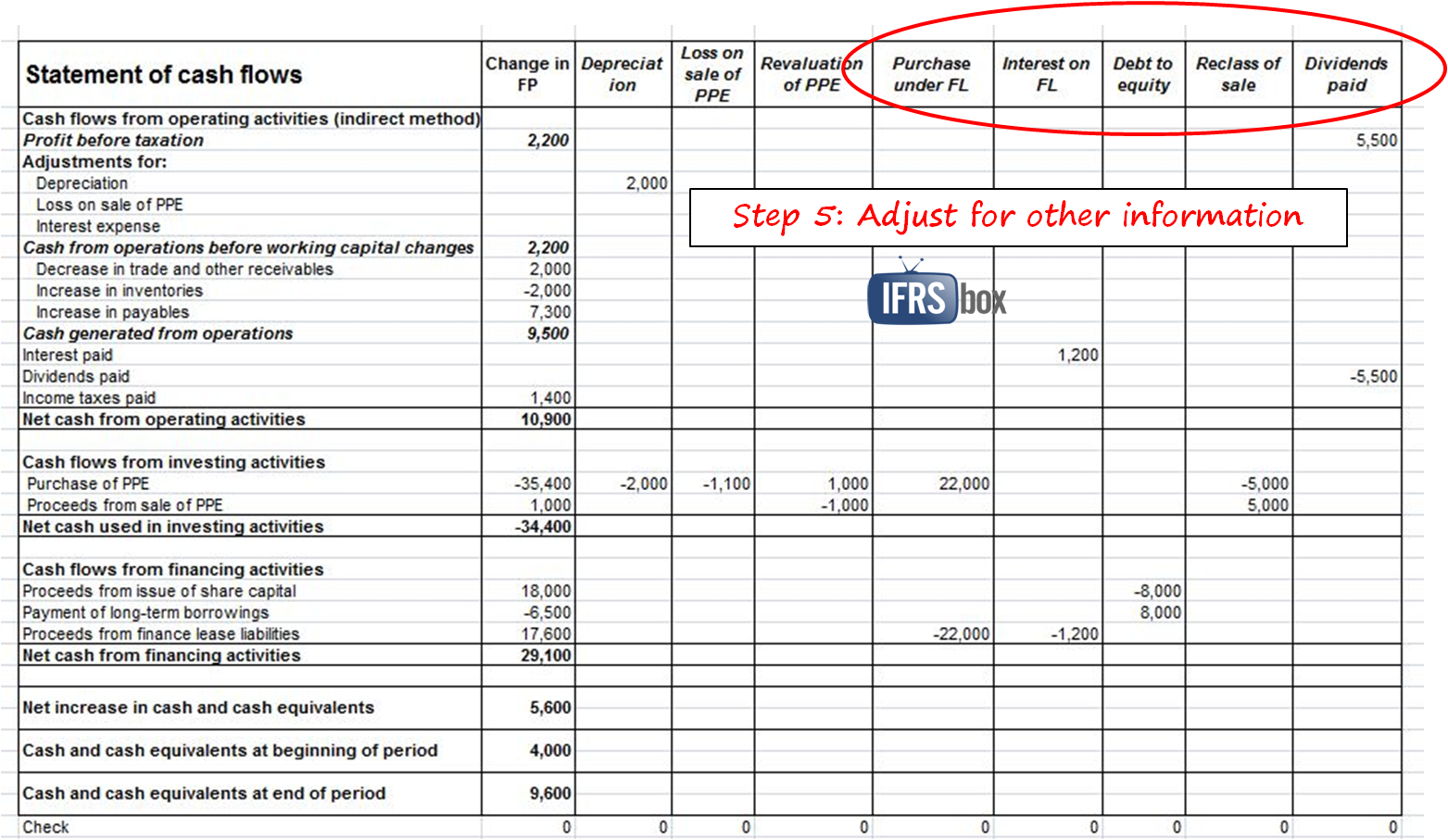
You can continue this way until you review all information you consider relevant or necessary. I just remind to make each adjustment in the separate column and check your totals to be 0.
Step 6: Prepare Movements in Material Balance Sheet Items to Verify Completeness
Well, this step is really for diligent, hardworking and dutiful people. You can skip it if you want, but I recommend doing it from very obvious reasons: you will be pretty much sure that you have made all material non-cash adjustments in your cash flows without omitting something important. Well, if you are sure that you have all available information from various departments in your company to include, than fine. But if you are unsure about it, then rather do this step.
It’s very easy. Just take the biggest or material items in your balance sheet and reconcile their movements between opening and closing balance. Check whether each movement is taken into account for in your cash flow statement so far.
For example, PPE. You might find out that movement of PPE was as follows: closing balance (from closing B/S) = opening balance of PPE (from opening B/S) plus cash purchases of PPE plus lease acquisitions of PPE plus PPE received as a gift minus depreciation of PPE minus loss on sale of PPE minus cash sale of PPE. Which items from this movement are non-cash? I suggest the following ones: lease acquisitions of PPE, PPE received as a gift, depreciation and loss on sale of PPE. So for each of those non-cash items, you should have made an adjustment. Have you? Fine. Have you not? Well, that’s why you do the movements—you identified another necessary adjustment, so make it.
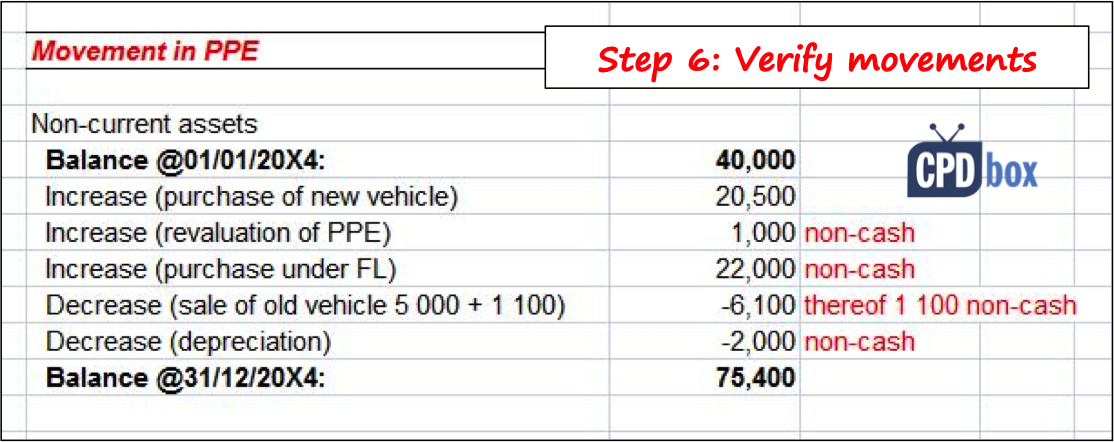
Step 7: Add Up and Perform Final Check
Let’s assume that by now you have done a lot of work, made a lot of adjustments, verified movements in material B/S items, your totals are always 0. Great job!
In this stage, finishing your cash flows is a piece of cake. What do you have in front of you? Huge excel file with 1st column being the headings and titles of your statement of cash flows, 2nd column being the changes in balance sheet and 3rd–xth columns being individual adjustments.
Now it’s time to draw the last column. And you guessed it—your last column will be the statement of cash flows itself. In the individual lines or items from statement of cash flows, you shall make “horizontal” or “line” totals, or in other words, sum up the numbers from columns 2 to x. You effectively calculate the change in the balance sheet for the individual caption adjusted by non-cash items, that gives you the appropriate cash movement for that caption.
Fine. Then verify if it makes sense. For example, you will get certain number in the line “purchases of PPE”—go and verify this number with your accounting records, or ask your investment department whether cash payments for PPE during the period were as you calculated. If not even close to that—you must have omitted something, or messed up signs or you made some other mistake.
Finally, look to “vertical” total of the last column—if it’s 0, you are the winner and deserve to sit back, close your eyes, relax…. but that’s topic for another article :-).
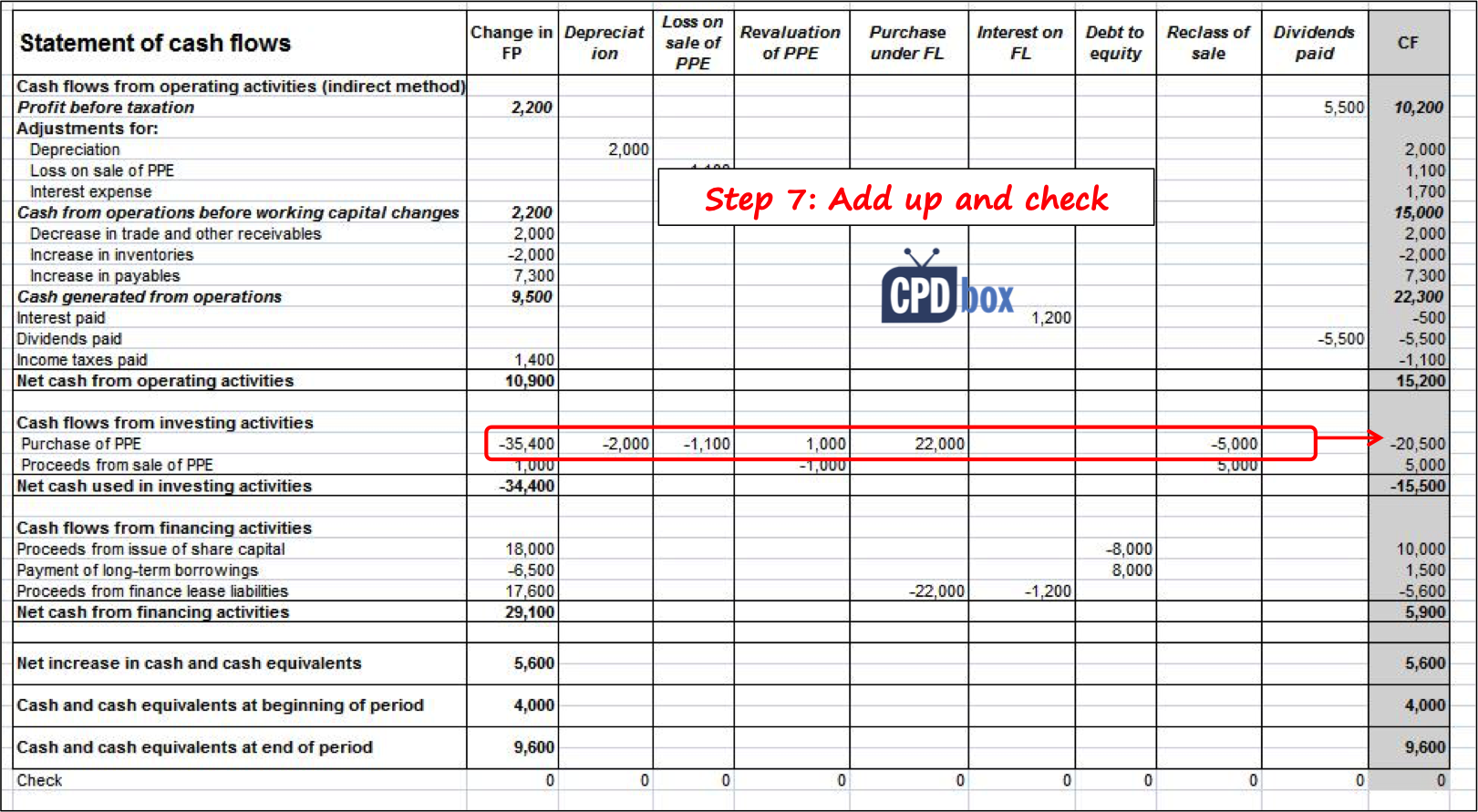
A Few Final Words…
Please bear in mind that my goal of this article was to draft a systematic approach for preparing a statement of cash flows rather than to explain the details of individual adjustments or other technical and factual issues. I just wanted to prove that it’s doable once you do it step by step.
You can see the video with this process here:
If you find it too difficult, or you do not understand all adjustments fully, or you need a clear demonstration, than I frankly encourage you to subscribe for our IAS 7: Statement of Cash Flows video course. You will not only learn about basics related to statement of cash flows, but also all above process is demonstrated very clearly in a comprehensive example and the most common cash flow adjustments are discussed.
Tags In
JOIN OUR FREE NEWSLETTER AND GET
report "Top 7 IFRS Mistakes" + free IFRS mini-course
Please check your inbox to confirm your subscription.
Recent Comments
- Albert on Accounting for gain or loss on sale of shares classified at FVOCI
- Chris Kechagias on IFRS S1: What, How, Where, How much it costs
- atik on How to calculate deferred tax with step-by-step example (IAS 12)
- Stan on IFRS 9 Hedge accounting example: why and how to do it
- BSA on Change in the reporting period and comparatives
Categories
- Accounting Policies and Estimates (14)
- Consolidation and Groups (25)
- Current Assets (21)
- Financial Instruments (56)
- Financial Statements (54)
- Foreign Currency (9)
- IFRS Videos (74)
- Insurance (3)
- Most popular (7)
- Non-current Assets (56)
- Other Topics (15)
- Provisions and Other Liabilities (46)
- Revenue Recognition (27)
- Uncategorized (1)

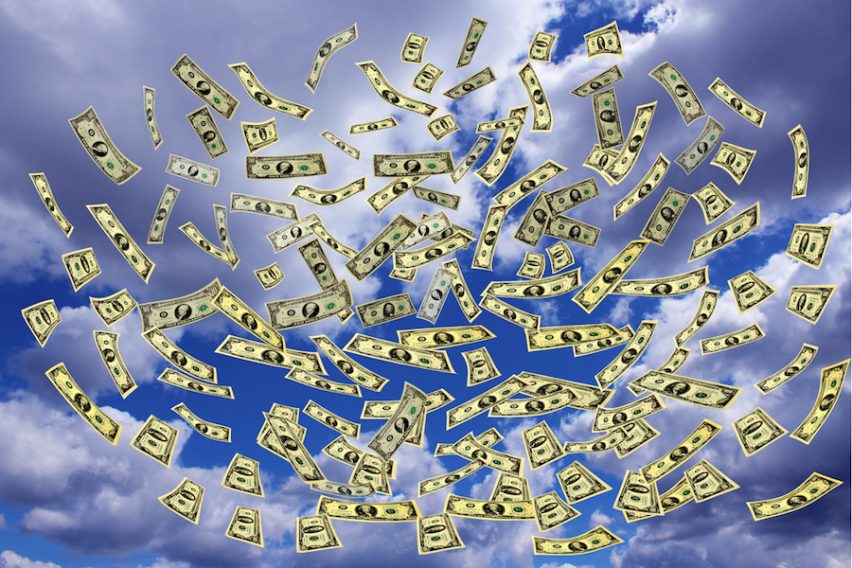



Hello Silvia
Very nice and well put together. Would be interesting to see how this could be applied to make consolidated cash flows easier. Specially when foreign subs are in the group structure.
Hi Hans,
in fact, this method works perfectly. However, you need to make sure that you prepare the individual statement of cash flows first in the respective functional currencies. Then, you translate foreign sub’s cash flow into the presentation currency and then, you add up and eliminate intragroup balances.
Many people make mistake when they try to make consolidated statement of cash flows based on consolidated balance sheets – this is wrong. S.
Thanks Silvia. Will give it a go.
Hi Sylvia
It worked. Doing the group cash flow statements is now so easy.
Perfect, glad it helped! 🙂
Dear Silvia,
Thanks alot for your work which you have done for all of us by creating this website and by helping others in a simple way. I have also some issues while preparing Financial Statements.
I have joined a new company, the employer had imposed on me that we did not prepared past two years accounts yet. so i need your kind help to prepare this task asap to continue my job.
Thanks
Dear Muhammad,
well, that’s a tough job. So what kind of help do you need? 🙂 S.
Hi Sylvia,
How does write-off of receivables affect cash flow statements?
Dear Dante,
it’s a non-cash item and must be adjusted as such. You add writeoff back to the profit figure and deduct it from the change in receivables. S.
Thank you Silvia for you reply.
I forgot to mention that we are using the allowance method in writing-off receivables. So, there is no nominal accounts affected in my journal entries.
i am m.com i got it useful for me to change mines from accountant to teacher in commerce .acrually its useful topic for me .i shall read it agian and agian to solve more illustirations .thanks .
its perfect lesson i used to learn and training a lot thank you alot
Dear Silvia it was very, very helpful. Could you please tell me about the provision for doubtful debts in cash flow. I added the provision for doubtful debts (non cash item) to the net profit in the operating category and deducted from the accounts receivables. Is this correct?
This is a great information. Thank you.
You just made life easier.
So glad to help! 🙂
I experienced a group which has set up a new holding company and acquired the subsidiaries via a non-cash share swap. How do we prepare such a cashflow statement to show transactions that only happen after the acquisition?
KK, all non-cash transactions are eliminated from the statement of cash flows and only real cash flows are shown. Having that said, I’m a bit confused by the question. When did the share swap happen? After the acquisition?
Great! I am glad to read this. thanks
This actually simplifies the cash flow preparation process, and I find it really helpful. Thanks for your time and effort. I just subscribed for more…
i dont undestand this steps if you do it am i supossed to do it look like step 7 at the end ?
Silvia, your IFRS Kit is amazing, I just bought it and the investment is worth it! Could you tell how is MEXICO doing in IFRS? Is Mexico taking steps in the implementation of IFRS?
Hi Silvia,
I’m having a doubt in this chapter,can u do me a favor??
What kind of favor?
Thanks. wow how easy was it. Very much appreciated.
Thank you Silvia for the information
the most important question here is how to determine the non cash transactions? and what is the exact criteria for selecting such a transactions.
this point required more research
thanks…………….
I am sitting in front of my laptop preparing our crazy Cash Flow Statement. We are a Pre-IPO entity doing app development business in China, what we do is like what Uber does in the US. I feel SO LUCKY came across this article, Silvia!! THE MOST practical article regarding CF I have ever read! I will definitely save this website address and looking forward your future sharing!
Best,
Cassie
Thank you Cassie, glad to help! 🙂
Such a wonderful article!!
Currently preparing for the CPA exam. Subscribed to IFRS in 1 day:) your lectures are fantastic. thank you!
Thank you so much for your kind cooperation
Thank you. Very helpful
Dear Silvia,
First of all it was really nice reading your article. it’s an amazing technique to prepare cash flow statement. Thank you for the great article.
I have certain queries regarding cash flow statement. Hope you will clear my doubts.
there is a foreign exchange loss which is a non cash item it will be added back to the profit and what will be the next effect for that. the company has already credited the amount of foreign exchange loss in their debtor account.
the company has paid the income tax interest which is adjusted through provision for tax. since it is a non cash items it is added back to profit what will be the next effect of that.
the company has the bad debt. since it is a non cash item it is added back to the net income in cash flow what will be the next effect of that
if we take tax paid at the end it is necessary to show the change in provision for tax account or advance tax account.
it would be very helpful if you clear my doubt regarding cash flow statement?
Hi Sushant,
let me try:
– foreign exchange loss: if you add it back to the profit figure, then you shall deduct it from the change in receivables (as it relates to your debtors)
– income tax interest – I don’t get it, what is the “income tax interest”? When you account for income tax expense, you do not add it back, because you start with the profit before tax figure (not the net profit). Income tax paid is then adjusted as a cash item.
– bad debt – deduct from the change in receivables
– yes. You can include it in the change of payables.
S.
Thank you silvia it’s a great help for me
Silvia, thank you so much, your explanations are so clear! I have always had trouble on this subject and you have made it so easy to understand!!
Thank you so much. The clear explanations really helped. I was stuck on this subject.
Silvia you have done great Job. I have enrolled for the ACCA UK IFRS Course, and now with your IFRS Box contents I am relieved from the tension of conceptual clarity. Will be joining soon your online Lectures… Thanks
Thank you! I wish you very best luck with your exams. Many of my students passed 🙂 You can do it, too!
Dear Silvia
Please reply to the following case:
My company is a hotels & compounds operater one of the ownwers of compounds sign a contract with my Co.
as per the contract we should have separate books for that compound (not yet done)
now three month passes & we start to operate the compound , books wise i booked all the transactions realted to the compound in current Ac under the name of the compound in our co’s book
Now I have auditor for three months & ask me to prepare proper FS’s , income statement & Balance sheet i do them however my question is how to prepare cash flow statement in this case??
Well, I would say in the consistent way with the balance sheet. As I understand, “compound” is not a separate entity and you book it within your own company. So if the numbers in the balance sheet are aggregated for the company and compound, do the same in the cash flow statement and disclose the facts in the notes.
S.
hi thank you very much,and can you please give me a link yso that I will purchase IFRSKIT Box or download it.i don’t know how to express my gratitude
Hi Njabulo,
thank you for your comment and interest! http://www.cpdbox.com/ifrs-kit
Or write me an e-mail, S.
Thank you so much Silvia for this website, has really helped me a lot in my work.
Really appreciate it.
Thank you.
Hi Silvia
You really made my day, when I went on the net I did not think I will come across such a practical approach to cashflow statements. THANK YOU and this is not the last time I visit your site and will definitely purchase some of your material on line.
Your the Best!!!
Thank you, my pleasure, and enjoy the website! S.
I’ve never seen an easier explanation than yours, Silvia. You are simply amazing. Keep it up.
Great lecture! Very helpful!
looks cool
Good staff. Its very much helpful to students
Hi Silvia,
I have a question in regards to retained earnings. I work for Government Health Services and One of the issues we are facing is that we have to purchase Capital equipments, but Department of Health have advise us, to use last year surplus from retained earnings to purchase those equipment, not sure How this will work,as what Journal entries we will pass to reduce the retained earnings for the capital purchases, as it will only decrease the cash flow.
Thanks allot
I have a question regarding Tax paid is it 1400 or (1400+2500)
As we have tax expenses of 2500 should be added to the decrease in the corresponding liability
Regards
Ahmed
Hi Ahmed,
unfortunately, adjustment for tax paid is not shown in the pictures (I’ve hidden some adjustments due to not enough space).
But the calculation of tax paid is as follows: Balance brought forward from previous year: liability of 700 PLUS tax expense (=increase in tax liability) of 2 500 MINUS balance carried forward at the year-end: liability of 2 100 = 700+2500-2100 = 1100 (which is shown in the final CF statement).
Hope it helps!
S.
Thank you for sharing this tips. it is very helpful
Thank you once more
wow…. awesome i do really appreciate it and i will make good use of it.. thnka very much
thanks a lot dear
I am looking forward to the helpful tips
I find your help profitable! I always ask myself a question, since you avalable to assist I think you can be of great solution to it.i am 34 and will be doing my last year next year in cost and management acounting and have a only retail job experience, so what are the chances of succeeding in this carreer easpecialy @ my age?
Dear Gavin! I truly believe that NOT following your desired path in any age is a waste of time. Meaning – go ahead with it, absolutely! Once I read a study that it took about 5 000 hours of work in a particular area to become an expert. What is 5 000 hours? Like 2-3 years in a full time job? So you would be 37-38 when being an expert? That sounds GREAT to me, you would still have a lot of years in front of you.
All the best! S.
Madam i dn’t know how to thankyou bt in short thanknyou for your efforts you are mento at a distance& i neva had a mentor since i resigned from project supervision as no1 blvd in me.is bng only 2weeks i coresponded on your page but i now gained above 30% knowledge i require.i thank God for you keepup the good job
Good article i appreciate your efforts please keep it up and wish all the best I am going to introduce it to my son who is studying bachelor of accountancy degree it is really a coincidence as i saw him yesterday(18/4/2014)studying the topic. By the way, I am also a certified public accountant CPA(T)
Thank you! I wish your son a good luck 🙂
Great Lesson.
OMG! ,there she goes again , just EXCELLENT!
Good work you have done here. IAS 7 strongly recommends direct method as opposed to the indirect method you have shown here. I believe direct method is quite complicated as cash book analysis is needed to prepare the method. How can one prepare direct method from the Income Statement and Statement of Financial Position.
You are completely right – IAS 7 does prefer direct method over indirect one. But the indirect method is easier and you are still compliant with IFRS if you make it this way. Up to you what you prefer. By the way, I cover the direct method in my IFRS Kit.
THE APPROACH IS EASY TO APPLY AND IT’S REALLY INTERESTING, I APPRECIATE IT! HOW DO YOU DO TO KNOW IN WHICH AREA PEOPLE NEED YOUR PROFESSIONAL SUPPORT AND TO KNOW IN WHICH WAYS THINGS USED TO BE COMPLICATED CAN BE HANDLED SO EASILY!YOU ARE MY BEST LECTURER I’VE GOT! THANK YOU SILVIA!
Thank you, Eric, I really DO appreciate and honor all my readers and subscribers. If I help just a little, it makes me feel great. All the best! S.
I’m so encouraged with this approach to solving cash-flow statement.
It’s super-easy, neat and clean, believe me! 🙂 Once you go through all this process, you’ll find it really a piece of cake 🙂 S.
Wish they had this website back when I was studying first year accounting
🙂 Thank you 🙂 But it’s still worth checking it now, isn’t it? S.
good
Thank You
how this course is useful to me for the practical knowledge
You will learn lots of practical stuff there, including making cash flow statements in a short while. Please read more on http://www.cpdbox.com/ifrs-starter-kit/
Silvia
I do really appreciate your tremendous and valuable efforts to make our life in accounts much easier than before with simplifying IFRS understanding process with extensive practical case studies to digest smoothly the IFRS and it is continuous changes.
Warm regards
Raed Idris
Kuwait
Thank you, Raed, I’m really happy to read this! 🙂 S.
I love you dear for your effort appriciated
your details are nice in practical and theory thanks a lot mam
Silvia the cash flow statement have you a knowledge for it?
hmmm, what are you asking me? I guess I have some knowledge as I wrote this article. S.
This is very comprehensive article and I think Silvia has made it logical presentation.
a great article and write up. Thanks for your kindness. I add your blog to my bookmarks. Many thanks.
Great Blog. I add this Blog to my bookmarks.
This is wrong, retained earnings is not profits, retained earnings don’t even appear in the cash flow statement, I know this and I am a first year
Well, to prevent misunderstanding: profit for the year is a part of retained earnings in the balance sheet. It is one of the changes in the retained earnings over the course of the year and if you are making statement of cash flows by this super-proven method, then you need to examine the change in retained earnings and consider if anything of it enters into the statement.
i would like to know 35400 is the adjusted amount for PPE how again u adjust the same thing from 35 4oo to arrive it cash flow amount though its get balance and CF shows correct value cos double entry has the facility of compensating errors still get the balance right.